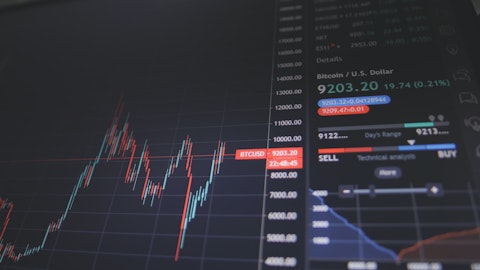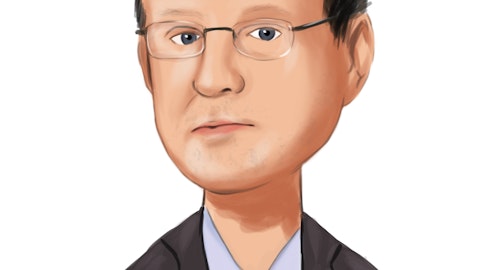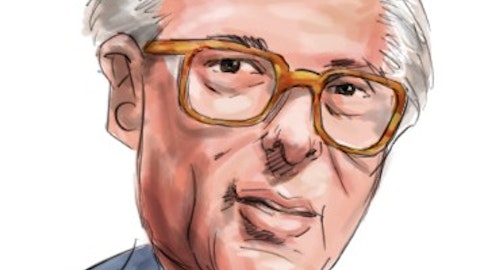Operator: Our next question comes from the line of Chris McGratty with KBW.
Chris McGratty: Obviously, the deposits are going to drive the size of the balance sheet. But if you look back, Paul, securities pre-COVID were around a little over 20% of earning assets. Is that kind of where we’re going to get to when the unwind of COVID fully plays out in your opinion?
Paul Burdiss: The key measure of liquidity that we utilize is liquidity stress testing. So not unlike our capital stress testing models, we have liquidity stress testing models. And I would say inherent in that are the assumptions around behavior deposits and draw-downs on commitments and sort of — those things that can make an impact, ultimately, liquidity. So based on all of that, a very long answer to your question, which is — probably requires a shorter answer, is that that proportion that you saw pre-pandemic with respect to the investment securities as a storehouse of on-balance sheet liquidity relative to the total assets is approximately where we would get to all other things equal.
Chris McGratty: Okay, great. And then I noticed more disclosure in the back on the office portfolio, which is great. Maybe just help us with how you’re thinking about where risk in the portfolio lies in €˜23, the highest risk if you were just kind of 1, 2 and 3. Thanks.
Harris Simmons: I think we’ll turn that over to Michael Morris, our Chief Credit Officer.
Michael Morris: Thanks for the question, Chris. The biggest, I guess, issue that we have are what we call repositioned assets where we’re waiting for some lease up, the assets were bought cheaply. And that absorption hasn’t followed through COVID. So, that’s a segment of office that we’re watching. We’re also thinking about it. Strategically, we’re looking down the road. We’re asking how will office be positioned? And will there be less office but more space? We’re looking at all kinds of variations of what office will look like. We have a pretty substantial suburban office mix, which has held up well. Central Business District office isn’t something we’re big into. You won’t see us in trophy buildings around the West and inside of our footprint. But we’re very cautious around the asset class right now.
Chris McGratty: Okay, great. And maybe just on the tax rate. Any thoughts going into €˜23?
Paul Burdiss: On the effective tax rate?
Chris McGratty: Yes, that’s right.
Paul Burdiss: I don’t see a big change from what we reported in — for the full year €˜23 — or sorry, full year 2022.
Operator: Our next question comes from the line of Peter Winter with D.A. Davidson.
Peter Winter: Thanks. So credit has been outstanding. I was just wondering how are you thinking about net charge-offs in €˜23? And then, secondly, if we’re at the appropriate ACL ratio, just assuming no change in the economy.
Harris Simmons: Well, I’m going to start with it. On the ACL, we think we’re through appropriate place having just certified that. I mean, we — the process we go through, I think, is pretty comprehensive, and we think it reflects the risk that is there today.
Michael Morris: So, I would say on the net charge-off front, this is Michael. We — if you look at historical run rates and you look at the last couple of years, we’ve also been, I think, really fortunate. And how long that could fortune last is something that we could all speculate about. But I think we have the right credit infrastructure to continue to manage net charge-offs. Well, we get good recoveries. We have a great back office special asset group that goes after charge-off loans aggressively, but it’s hard to say that we can keep net charge-offs as low through what is anticipated to be potentially a milder recession forthcoming.
Scott McLean: This is Scott McLean. I’ll just add to that that I think the other thing, you just have to look at where do you think risk is really going to come from in a decline. And we’ve said pretty consistently that it’s probably going to come in consumer unsecured. We don’t have, hardly any consumer unsecured. It’s probably going to come in construction loan portfolios, and our construction portfolio is about 20% of total CRE. The rest of our CRE is term, which is those are stabilized cash flows with low loan to values. Third place might come in land portfolios. We have very little land. So, I think those are areas. Leverage finance is another area that gets brought up. That’s not really disclosed, although we think Moody’s is going to do a report on that sometime in the first half of the year.
And we think, as we did last time, they did one, will probably compare favorable to our regional bank peers. So, it’s kind of like where do you think it’s going to come and do we have that? And the answers are we’re positioned pretty conservatively.
Peter Winter: Got it. And then, Paul, if I could just ask about maybe the outlook for deposit growth this year, or maybe do you think it would stabilize in the second half of this year?
Paul Burdiss: Yes. As I said, the key lever for deposits in this environment, I think, is rate. And so, I’m not — it’s very difficult to predict deposit balances because ultimately, it’s highly dependent on customer behavior, but I certainly would expect us to strike maybe an improved balance between rate and volume over the course of the next year. When we consider the alternative cost of funds, our all-in cost of deposits at 20 basis points is fantastic. But also, as Harris said in his opening remarks, we are in a position with a lot of flexibility in our balance sheet, and we feel like there are many levers that we could pull to change the deposit growth profile.
Operator: Our next question comes from the line of Ken Usdin with Jefferies.





